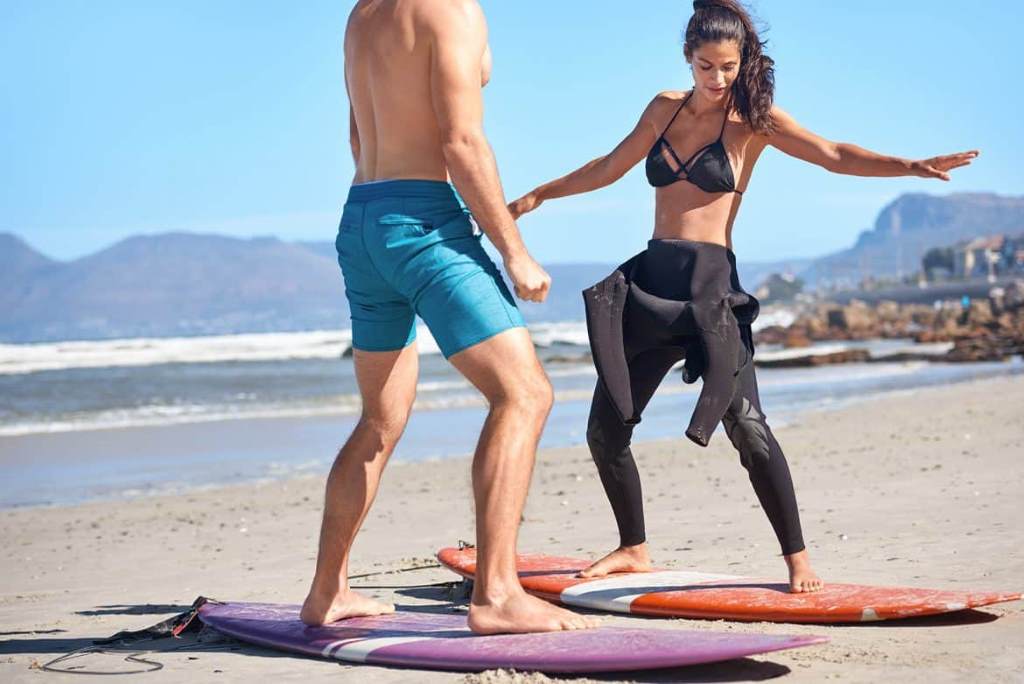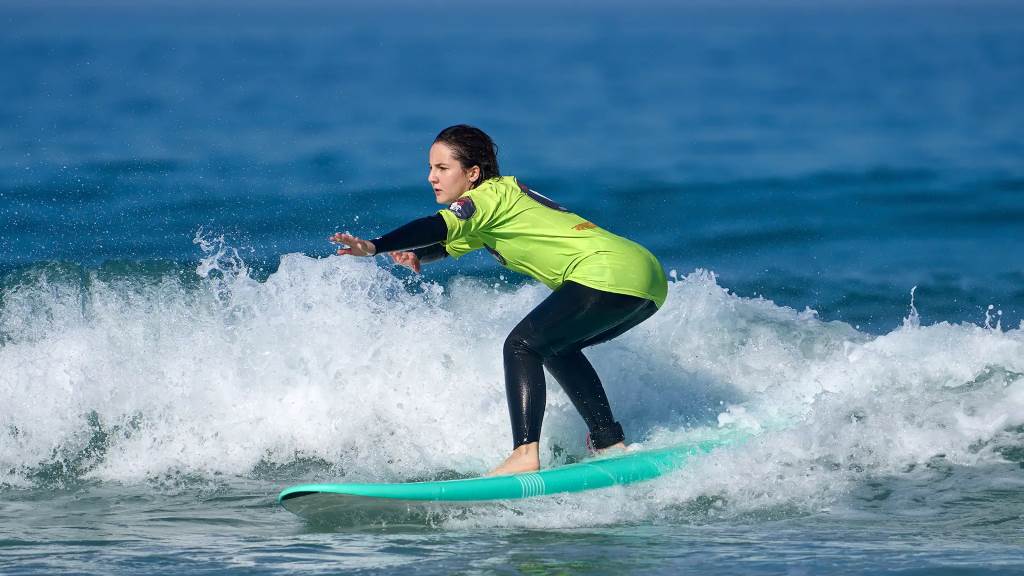Growing up near the ocean, I spent countless summer days watching surfers glide effortlessly on waves, their balance a mesmerizing dance with the sea. As a beginner, I quickly learned that mastering balance is the heart of surfing, turning chaotic waves into a graceful ride. This blog post shares practical tips and personal insights on how to improve balance for surfing, blending tried-and-true techniques with stories from my own journey. Whether you’re a novice or refining your skills, these strategies will help you stay steady on the board.
Understanding the Role of Balance in Surfing
Balance is the foundation of surfing, dictating how well you control your board on unpredictable waves. It’s not just about standing upright; it’s about syncing your body with the ocean’s rhythm. Core strength, proprioception, and quick reflexes work together to keep you stable. According to a 2018 study by the Journal of Sports Science, surfers with stronger core muscles maintain better balance during dynamic movements, reducing fall rates by 30%.
My first attempts at surfing were humbling—falling off the board felt like a rite of passage. Over time, I realized balance isn’t just physical; it’s mental. Staying calm under pressure helps you adjust to shifting waves. Practicing on land, like standing on one leg, builds the muscle memory needed for the water. Start with simple exercises to train your body to react instinctively.
Core Strength: The Key to Stability
A strong core is your anchor on the surfboard. Muscles like the obliques, abs, and lower back stabilize your body, letting you pivot and adjust mid-wave. A 2020 study in the International Journal of Sports Medicine found that surfers with consistent core training improved their balance by 25% within eight weeks. Planks, Russian twists, and leg raises are excellent for building this strength.
When I started surfing, my core was weak, and I wobbled constantly. Adding daily planks to my routine made a huge difference—within a month, I could hold my stance longer. Try incorporating three sets of 30-second planks into your day. Pair them with dynamic movements like medicine ball twists to mimic surfing’s rotational demands. Consistency is key, so stick to a routine.
Balance Board Training for Surfing Success
Balance boards are a game-changer for surfers. They mimic the instability of a surfboard, training your body to adjust to shifting surfaces. Using one for 15 minutes daily can sharpen your reflexes and proprioception. A 2021 study by the American College of Sports Medicine showed balance board users improved dynamic balance by 20% compared to non-users.
I bought a balance board after struggling to stay upright during my first surf lessons. At first, I could barely stay on for 10 seconds. But practicing daily, I started feeling more confident on the water within weeks. Start with a basic board and try simple exercises, like rocking side to side. Progress to single-leg stances or squats for added challenge. For local practice spots, check out where to surf in New York for coastal areas with great training vibes.
Yoga and Flexibility for Fluid Movements

Yoga enhances balance by improving flexibility, core strength, and mental focus. Poses like Warrior III and Tree Pose train single-leg stability, crucial for surfing. According to a 2022 study in the Journal of Physical Therapy Science, yoga practitioners improved balance and reduced injury risk by 15% in dynamic sports. Yoga also calms the mind, helping you stay focused on unpredictable waves.
My first yoga class felt awkward, but poses like Tree Pose taught me to center my weight. Over time, my surfing stance became more fluid. Try a 20-minute yoga flow three times a week, focusing on balance poses. Pair this with deep breathing to stay calm during wipeouts. Local classes or online sessions can fit any schedule, boosting your progress.
Functional Training for Real-World Surfing
Functional exercises mimic surfing’s dynamic movements, building strength and coordination. Squats, lunges, and kettlebell swings train your legs and core to handle quick shifts on the board. These movements improve your ability to pop up and adjust mid-wave. Research from the National Strength and Conditioning Association (2023) shows functional training boosts athletic performance by 18% in sports like surfing.
I added kettlebell swings to my workouts after noticing my legs tired quickly on long rides. The explosive movement strengthened my quads and glutes, making pop-ups smoother. Try three sets of 15 reps for squats and lunges, focusing on form. Incorporate these into your weekly routine, ideally three times a week, to see results on the water.
Read More:
Sustainable Surfboard Materials
Top 4 Factors That Affect Sports Lighting in Stadiums
Mental Focus and Visualization Techniques
Surfing demands mental clarity to anticipate waves and maintain balance. Visualization—mentally rehearsing your ride—can improve performance. A 2019 study in Sports Psychology found athletes using visualization improved motor skills by 12%. Picture yourself balancing on the board, adjusting to the wave’s flow, before hitting the water.
I used to panic when waves shifted, throwing off my balance. Visualization helped me stay calm and focused. Before sessions, I’d close my eyes and imagine a perfect ride. Try spending five minutes daily visualizing your surf. Combine this with deep breathing to reduce anxiety. Over time, this mental prep will make your movements more instinctive, enhancing your balance.
Practicing on Land to Master the Water
Land-based practice builds the skills you need for surfing success. Drills like pop-up practice or single-leg stands prepare your body for the board’s instability. Use a yoga mat to simulate pop-ups, focusing on quick, controlled movements. Consistent land practice translates to better wave performance.
My early surf sessions were frustrating until I practiced pop-ups at home. I’d lie on the floor, mimicking the motion daily. Within weeks, my transitions on the board felt smoother. Dedicate 10 minutes daily to land drills. Combine pop-up practice with balance exercises for maximum impact.
Nutrition and Recovery for Optimal Balance
Proper nutrition fuels your body for balance-intensive surfing. Hydration, protein, and healthy fats support muscle recovery and endurance. A 2020 study in Nutrients journal found that balanced diets with adequate protein improved athletic performance by 10%. Stay hydrated and eat meals rich in lean protein and complex carbs.
After long surf sessions, I noticed fatigue hurt my balance. Adding protein shakes and hydration to my routine helped me recover faster. Aim for 1.6 grams of protein per kilogram of body weight daily. Rest days are crucial—schedule at least two per week to avoid burnout. Proper recovery ensures your body is ready for the next wave.
Joining a Surf Community for Support
Surfing communities offer tips, encouragement, and shared experiences that boost your skills. Local clubs or online forums connect you with surfers who share balance-improving techniques. Engaging with others keeps you motivated and accountable.
I joined a local surf group and learned balance tips from seasoned surfers. Their advice, like focusing on knee bends, transformed my rides. Seek out communities through events or platforms like Surfline. Attend meetups or join online groups to exchange ideas. These connections make learning fun and effective, helping you improve balance for surfing.
Conclusion
Improving balance for surfing is a journey of physical and mental growth. From core workouts to yoga, balance boards, and mental focus, each step builds your ability to ride waves with ease. My own path from wobbly beginner to confident surfer taught me that consistency and community are key. Explore resources like where to surf in New York to find spots that inspire practice. Keep training, stay patient, and embrace the process. Share your surfing tips or experiences in the comments below, or spread this article to help others ride better waves! For inspiration, explore NewYork Big Event to know about local surfing festivals that spark passion and community.
FAQs
Why is balance important for surfing?
Balance is crucial for surfing as it helps you stay stable on the board, control movements, and adapt to shifting waves, ensuring smoother rides.
What exercises improve balance for surfing?
Core exercises like planks, balance board drills, and yoga poses such as Tree Pose enhance stability and coordination for better surfing.
How does yoga help with surfing balance?
Yoga improves flexibility, core strength, and mental focus, helping surfers maintain balance on dynamic waves and stay calm under pressure.
Can mental focus improve surfing balance?
Yes, visualization and deep breathing enhance mental clarity, helping surfers anticipate waves and maintain balance during rides.
















+ There are no comments
Add yours